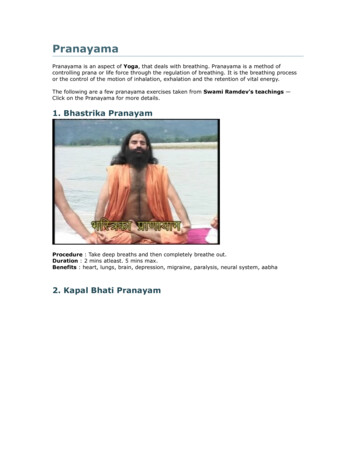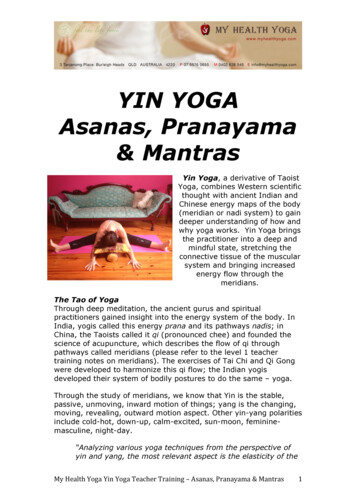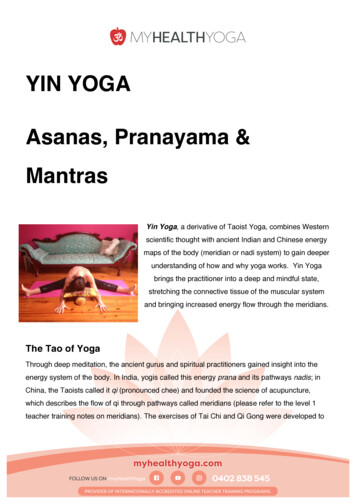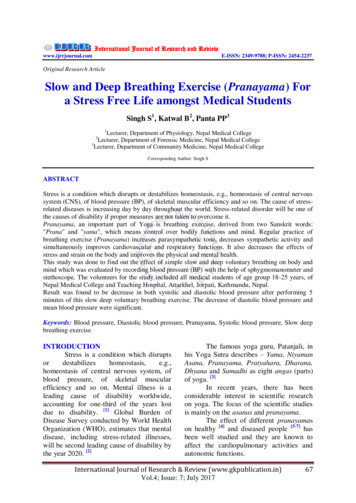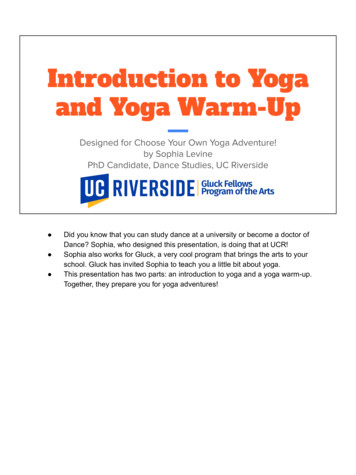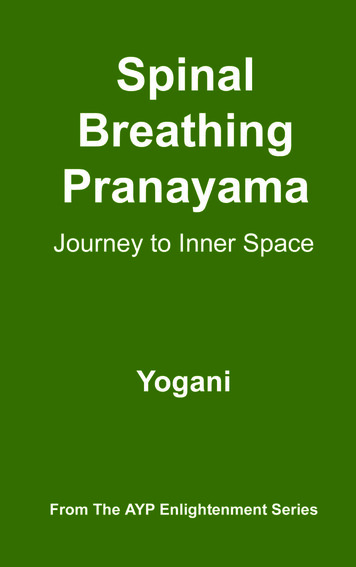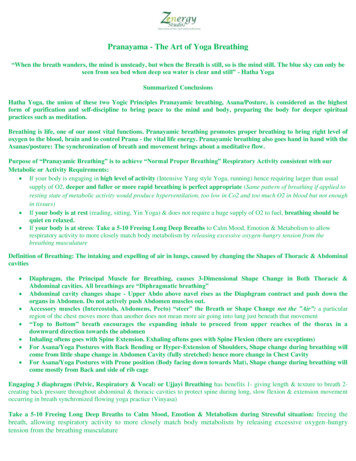
Transcription
Pranayama & The Art Of BreathingWritten by Christine Breese, D.D., Ph.D.IntroductionThe Sanskrit word pranayama (also known as pranayam) is translated as “the science of breath” in somecircles, and in others it has a broader meaning, “expansion, manifestation of energy.” Pra (first unit) na (energy)is the vital and primal energy of the universe. According to some Eastern Indian writings, the universe comesfrom akasha (ether, space) through the energy of prana. Akasha is the infinite, raw material of the universe.Prana is the infinite, raw energy of the universe. One who has learned how to control prana controls all theenergies of the universe, thus controlling his or her body, emotions and mind.Even though prana is a term loosely used to cover all energies, ancient manuals of yoga speak of tenpranas, five major and five minor ones. The five major pranas are udana, prana, samana, apana, and vyana.Udana rules the upper part of the body from the larynx up, and governs use of special senses beyond the fivesenses. Prana rules between the larynx and the heart, governing speech, breath and the respiratory system.Samana rules between the heart and the navel, governing all metabolic activity in the act of digestion. Apanarules below the navel and governs the kidneys, colon, rectum bladder and genitals. Vyana permeates the entirebody and governs relaxation and contraction of all muscles, voluntary or involuntary. It also governs the jointsand their movements. By controlling the prana (breath) one can access and influence all the other pranas, whichexplains the universal usage of this word for representing all the pranas.Energy and matter bear an important connection with each other. They are one and the same, really. Ifmatter is dispersed, energy is the result. If energy is condensed and harnessed, matter is the result. It takes a lot ofenergy to make only a little bit of matter. It takes only a little bit of matter to make a lot of energy. One quarterpound of matter would be the equivalent of 200 H‐bombs going off, about 200 times the power of the bomb thatdestroyed Hiroshima. Obviously, scientists are interested in learning how to convert matter and energy back andforth, but as a species, we are far from utilizing these physical laws, especially in a benevolent way.Breath is an energizing force concerning the matter in our bodies. Energy is referred to as prana inSanskrit terms. Breath is our first and foremost energy, carrying over to all the other bodies after reaching thephysical body. Even the physical body comes after energy, not before. We talk about mental energy, emotionalenergy, physical energy, spiritual energy all of these are types of prana. If one wants to alter any of thesestructures, one would do so through prana. Prana is the vital link between all of these structures. In ancientEastern Indian scripture, five prana are described, each having its separate function. The pranic sheath has acomplex anatomy. In it are pathways called nadis. Through them, breath flows and is converted to the energyforms that are needed by the different “bodies” of the human, not just the physical body.In the body, energy is constantly being consumed, produced and exerted. It is being shifted from point topoint, creating an energy flow. Different kinds of breathing create different types of energy flow. Fast breathingcreates shorter waves of energy, bursts of energy, and slow breathing creates longer waves of energy, steady slowfrequencies of energy. Different types of energy flow create different results and states of mind.Everyone develops habitual ways of breathing or moving energy, and there are differences from onebody to the next as to its health and vitality. If the energy flow is changed, the body will change. For instance, if aperson learns to breath differently, less shallowly, the body will change for the better. If a person’s breathingbecomes less open, the body will change for the worse. A shock or injury can also change a person’s breathingand energy flows, and it may result in a change of posture or other factors that affect energy flow. If the body isundernourished, concerning energy, it will become sickThere is much speculation as to how one might affect different types of energy flow through the breath,and thus attain different results in physical, emotional, mental and spiritual states. One who sits down andpurposely alters his or her breathing patterns will gradually see changes in the way his or her body, emotionsand mind function. Some animals are able to regenerate body parts, and this is most likely because there is somesort of persistence in the energy flow, causing matter to manifest. People who have had limbs amputated alwaysreport still feeling the limb, and it may even be painful. This is also because there is still an energy flow there, theenergy that precedes the manifestation of the physical body. The physical body is nothing more than acrystallization of energy patterns that underlie it. It is seen in Kirlian photography that if a leaf is torn in half, thePranayama & The Art Of Breathing 2005 University Of Metaphysical Sciences1
energy of the half that is gone is still there, quite intact. It is possible that if the energy of human limbs that aremissing persists long enough, the physical manifestation would eventually reappear. Some plants do regeneratethis way. This is why plants seem to grow back even stronger and fuller when they are pruned back. They have aburst of energy to replace that which was lost. There are even animals that can grow limbs back.There is one cell in the very beginning of a human form. That cell then divides, and continues to divide.But what causes these cells to turn into a skin cell, a muscle cell or a bone cell? What tells them to be a heartinstead of a leg? It is the underlying pattern of energy that is the template for the human body. The cells arefollowing a guide, a field of forces around which they shape themselves. If there was no template, there would beno organization of the these cells and it would just be the same kind of cell over and over again, never turninginto something different from the cell it was divided from.The Upanishads, ancient Eastern Indian texts, say that the pranamaya kosha (energy body) is created byeven a deeper level of existence called the manomaya kosha (mind). The mental is even subtler than the energy(prana), which it uses to create physical matter. In this era, most of the mainstream population believes that thebody comes first and gives rise to the mind. Most people believe that the fetus or embryo has no mind and that itspersonality and mind evolve from the physical body. It is believed that the Earth formed out of mindlessmaterial, and life arose from this lifeless soup, eventually emerging into a consciousness like humankind.However, it is actually the other way around.Eastern thought has been quite opposite of Western thought, believing that consciousness is the one thathad the idea of creating matter in the first place, a vehicle in which to have experiences in a physical reality. Firstcame consciousness, then the mind, the mind being the first manifestation created by consciousness. Out of themind comes the manifestation of physical, material existence. Out of this came the human, animal and plantbodies. We are born of something beyond physical existence, and it is to there that we return. This implies thatour existence is born out of something that precedes physical reality, and this is a disconcerting thought to theWestern way of thinking. Out of the nothingness, mind and physical reality appear, and then it disappears backinto that same nothingness after it is experienced. Consciousness expands into manifestation, and then itcontracts back into nothingness, expands again, and then pulls back. The entire universe is nothing more than acosmic exhalation and inhalation process. This process of the coming and going of experiences is evident in allthings. Humans and animals breathe, and so do plants. We are born into manifestation, and then we die,returning to that which preceded the physical body. The cosmic breath is happening right here inside yourhuman body even as you read these words.Pranayama & The Nervous SystemThe nervous system contains the central and autonomic nervous system. The central nervous systemconsists of the brain, twelve pairs of cranial nerves, the spinal cord, and thirty‐one pairs of spinal nerves. Thecranial and spinal nerves spread throughout the body. These nerves send out and send in to the brain pain andmotor impulses. Prana flows throughout these pathways. It also flows through all the nadis, or energeticpathways, which have been studied by ancient yogis and correlate with many of the meridian paths described inliterature about acupuncture techniques.Nadis means channels or vehicles. Some texts describe 72,000 nadis in the body, other texts mention asmany as 350,000 of them, but fourteen are considered important, and only six of them are the most important ofall. They are called the ida, pingala, sushumna, brahmani, chitrana, and the vijnana. Among these six, three areeven more important than any others. These are centered on the spinal cord, wrapping upward. We learnedabout these in the UMS Chakras & Auras course while exploring kundalini. Here we will look at how they relateto the nostrils and breathing.Pingala (surya) flows through the right nostril. Ida (chandra) flows through the left nostril. Both criss‐cross back and forth across the spine. Sushumna is the central pathway moving straight down the middle of thespine and is the moment when both nostrils are open and operating equally. The meditative expansion of thatmoment is called sandhya, a state in which the meditator cannot be disturbed by sounds, thoughts, or any otherdisturbance from within or without. It is a “magic moment” or “magic zone.” All three of these nadis begin in thebase of the spine, in the root chakra, or mudladhara.When the ida and pingala criss‐cross back and forth across the spine, intersecting with the sushumna,these intersections are the chakras. Five of them are on the spine and the uppermost two are in the head. The onesPranayama & The Art Of Breathing 2005 University Of Metaphysical Sciences2
in the head do not have the criss‐cross action from the nadis. The ones on the spine do. The ida, pingala, andsushumna are the three main nadis, but multitudes of other nadis radiate out from the chakras as well.Scientists have attempted to compare the nadis to what we know about modern anatomy, but they do notcorrelate as exactly as scientists would like. Even though nadis bear a terrific resemblance to the nervous system,they cannot be detected through dissection. They are part of the energy body, which supports the physical body.The physical body is built around the energy system of the nadis. The nerves belong to the physical body and thenadis belong to the subtle body, two different systems indeed.The techniques of pranayama are designed to bring the central nadi, the sushumna, into primaryfunction, rather than the ida or pingala dominating the functions of prana flow. With activation of the sushumnaas the primary flow for prana, the yogi experiences freedom from the human condition, and joy. By opening upflow of the sushumna, the yogi raises kundalini, the sleeping serpent, from the root chakra, the mudladhara. Thiskundalini energy, which is very powerful, passes through and blows open each chakra. The resulting states ofconsciousness, represented by the thousand petalled lotus, the crown chakra at the top of the head, is consideredthe highest state a person can reach in the human form. It is union with cosmic consciousness, beyond time andspace, and also called shakti. The person merges his individual self, soul, or atman, with the cosmic soul, orBrahman.Pranayama is one of the pieces of raja yoga (royal yoga). The first four pieces are yama (restraints),niyama (observances), asana (postures), and pranayama. The next four pieces of raja yoga are pratyahara (sensewithdrawal), dharana (concentration), dhyana (meditation), and samadhi (superconscious state, freedom fromreincarnational cycles).Controlling breath and nerves results in controlling the mind, and controlling the mind results infreedom. According to yoga, disease is the result of imbalance and blockage in the flow of prana. Psychologistshave discovered that there is a connection between personality types and breathing patterns. The yogi believesthat by changing the pattern of breathing, one can transform the personality. When the mind is disturbed, thebreath is disturbed and vice versa. By making the breath deep, even, and smooth, the mind relaxes and thus thepersonality changes, or the physical disease goes away.One of the aims of yogic breathing, the practice of pranayama, is to regulate this unequal flow of breaththrough the nostrils, bringing balance between them, and having both nostrils equalized in their flow. Thisequalization devitalizes the ida and pingala and opens up the blocked sushumna nadi. Equalizing the flow ofbreath in the left and right nostrils brings health, balance and harmony to the mind and body. This is not done ona 24 hour per day basis, however, for this would actually cause an imbalance. It is simply useful for determiningwhich side is dominant at any given time if a particular activity is coming up that would be served better byusing one side or the other as the dominant affector.Breath Awareness In MeditationTuriya is the highest state of mind possible. It is the seventh level of breath awareness in meditation.Since the beginning of life, the child learns how to move, not how to be still. The yogi learns how to be still. It cantake many years to learn how to be still. Most teachers of meditation teach the student breath awareness beforeleading the student to more advanced methods of meditation. Deeper states of meditation simply cannot bereached without awareness and control of the breath. The mind identifies with the outer world, and in order to beaware of that which is beyond the mind, perfect stillness and tranquility must be achieved.The first thing to become aware of is the breath. Many people wonder why their meditations are notmore powerful or deep, but usually it can be traced back to the fact that they are not, nor have ever been, awareof the breath. Awareness of the breath is the first movement of the mind inward.The following is a series of steps inward in breath awareness:1. Find a comfortable posture.2. Develop calm, serene breathing.3. Develop a calm and steady mind.4. Control the conscious mind.5. Control involuntary processes and the unconscious mind.6. The mind becomes aware that it is conditioned by time, space and causation. Train it to becomeaware of the now, an essential part of understanding eternity.Pranayama & The Art Of Breathing 2005 University Of Metaphysical Sciences3
7. Turiya is attained, the highest state of bliss, peace, happiness, and wisdom.The mind forms habits, ruts that it uses for thought processes. Meditation is not about allowing the mindto wander aimlessly, but harnessing the mind and making a conscious effort to coordinate the body, the breathand the mind. In teacher/student traditions, the teacher waits until there are signs in the student of body/ mindstillness and serenity of the breath. When the student has successfully stilled the mind and body, more advancedstates are taught.For the beginner in meditation, it is common for him or her to experience elevated itching, twitching,muscle spasms, and pain. These may be movements that there was no awareness of before. All of thesemovements are caused and reflected by the untrained mind. No act is independent. The mind moves first, andthen the twitching or itching ensues. When the student has learned to be still in the mind, the body becomes stillas a result. In meditation, the first thing one must do is learn how to sit still! This is a tall order for some people.Breath awareness prepares the student for higher levels of consciousness. A one‐pointed mind isabsolutely necessary before meditation can truly take place. Just closing one’s eyes and trying to think of nothingis not meditation. That is preparation for meditation. Pranayama can be the doorway to true meditation.Sushumna is the name of the central nadi. It is also the name for “joyous mind.” There are techniques fordeveloping sushumna, which is the prerequisite for true meditation.1. Concentrating on the bridge between the two nostrils2. Doing pranayama exercises and using the jalandhara bandha3. Meditating on the chakra systemCellular RespirationCells are tiny, individual, living, sentient beings. Their life is dependent on the flow of energy, prana.Usually one thinks of the food eaten as the source of energy, but this is not the case in its entirety. The food isuseless to the body without the oxygen. The air is also supplying prana. The food is then “burned” in the body,creating energy, but the oxygen is necessary to convert it.A fire is a fast and hot “explosion,” which is obviously not the kind of burning that the body does. Thebody could be seen as a slow burning furnace. This slow burning furnace creates energy by combining food fuel(carbon) with oxygen, thus producing CO2 (carbon dioxide). In a visible fire, light is visible because the burningis so rapid. In the body’s “fire,” the burning happens so slowly that light is not visible, except in the auric fielddisplayed by Kirlian photography.All living organisms are, in essence, slow burning furnaces, creating energy out of the burning of foodwith its proteins, carbohydrates and fats. Sometimes the energy is not used in the moment that it is created, so itis stored in an energy storage molecule called an adenosine triphosphate, or ATP, and this is found throughoutbiological systems throughout nature.Cell respiration is, then, a situation where nutrient fuel is burned with oxygen to release energy. Therespiratory system of the body delivers the oxygen and makes it available to the cells. A change in the respiratorysystem, blockages, poor conditions, or pollutants covering the lungs, all of these can seriously contribute to theinability of these cells to function as tiny furnaces.Circulatory System & OxygenIn order for the oxygen to be delivered to the cell, it must go through a myriad of systems before it getsthere. Oxygen travels through the lungs and the circulatory system before it reaches the cell. The oxygen entersthe trachea (throat), splits off into two tubes supplying each lung, and then branches off into even smallerbranches until these branches become microscopic in size. After many branching levels they end up in tinybronchioles which bring the oxygen into little air sacs called alveoli. These air sacs are so tiny that the lung tissuein this area looks solid to the naked eye. Here is where the gas exchange takes place. It happens in these cell‐sizedbubbles.Blood vessels surround the alveoli and the blood cells bend to fit into these bubbles. The blood grabs theoxygen molecules and carries them off into the blood stream. The blood is not, however, distributed evenlyaround these alveoli, which deliver the oxygen. When one is standing, the blood is thickest around the bottom ofthe lungs. However, gas exchange is greater in the upper portions of the lung. The degree of efficiency of oxygentransfer can be changed by compensating reflexes in the lungs, and the way a person habitually breathes.Pranayama & The Art Of Breathing 2005 University Of Metaphysical Sciences4
Smoking is about the worst thing anyone can do to his or her breathing apparatus. Emphysema is theresult of cigarette smoking and every smoker has it to some extent or another, even if the more serious symptomsof emphysema are not prevalent. Smoking breaks down the lining in the alveoli and this happens slowly over aperiod of years until a full‐blown case of emphysema is evident. If the alveoli were flattened and spread out, theywould cover the space of an entire floor of a house or apartment. This is why it takes so long for emphysema toshow up. Pre‐emphysema symptoms would be “shortness of breath” for not as many alveoli are being utilized asshould be.Hemoglobin molecules within red blood cells transport oxygen in the bloodstream or it is directlydissolved in the blood. Most of the oxygen is carried in the hemoglobin molecules. These molecules are made upof four protein chains attached to an atom of iron. Iron is what the oxygen is attracted to, and this bonding causesthe blood to be bright red. When hemoglobin transports the waste material from the cells after the conversion ofthe fuel and oxygen, it carries CO2, causing the blood to be bluish. Arterial blood, the vessels that deliver theoxygen, tend to be in the inner parts of the body and these are red. Venus blood carries the waste products awayand tends to be on the outer parts of the body. Venus blood is blue.O2 and CO2 should be the only molecules that bind to hemoglobin, but sometimes there are other gasespresent in the air that can enter the bloodstream via the lungs. These gases can crowd out the O2 and cause acrisis. One of these is carbon monoxide, found in cigarette smoke and automobile exhaust. Carbon monoxide is240 times more likely to attach to hemoglobin, and this results in a decreased amount of hemoglobin available tocarry O2, creating a type of anemia. A person who smokes has somewhere between 5‐15 % of his or herhemoglobin tied up in transporting carbon monoxide, a toxic substance, rather than carrying oxygen. Carbonmonoxide causes damage. It also hardens the arteries, leading to heart attacks and strokes.If this is not knowledge that will cause you to stop smoking if you are a smoker, then nothing will. Eventhough this knowledge is quite prevalent, and every one knows that smoking causes these problems, still theepidemics of emphysema, heart attacks and strokes go on. (To be fair, heart attacks and strokes can be caused byother factors as well.) This leads one to conclude that people who smoke may secretly harbor a death wish, evenunbeknownst to themselves.Once hemoglobin carries an oxygen molecule, it travels throughout the body and finds cells that need theoxygen. The driving force is the heart. The right side of the heart takes CO2 rich blood from the body and pumpsit into the capillaries surround the alveoli in the lungs and gas exchange occurs. This blood then becomesoxygenated and the CO2 is expelled through the exhaled breath. This oxygenated blood is redistributedthroughout the body by the left side of the heart.The oxygenated blood moves into increasingly smaller blood vessels until it reaches some that are assmall as the alveoli. A gas exchange similar to that in the lungs occurs between the cell and the hemoglobin. Thecell takes the oxygen molecule and gives the hemoglobin CO2. The blood again turns blue. The hemoglobin thentravels into increasingly larger vessels until it goes through the right side of the heart and ends up in the lungsagain.Three Types Of BreathingThe diaphragm is the muscle that causes the lungs to move and is located underneath the lungs, abovethe stomach. When the diaphragm moves downward, the lungs inhale. When the diaphragm moves upward, thelungs exhale. Diaphragmatic breathing is evident when the lower belly extends on an inhale rather than the chest.There are three types of breathing, which will be expounded upon more as we move further into this material:thoracic breathing (mid‐chest), clavicular breathing (upper chest), and diaphragmatic breathing (belly, abdomen).Diaphragmatic breathing is the most efficient breathing there is. This is because most of the blood is circulating inthe lower parts of the lung, and oxygen infusion is mostly happening there. The diaphragmatic breathing pullsthe oxygen lower into the lungs, thus increasing the efficiency of oxygen infusion into the blood stream becausethe oxygen is exposed to more of the blood. Interestingly, children and infants do this naturally. It is only laterthat adult humans stop using this most efficient way of breathing.Thoracic Breathing, chest breathing, fills only the middle and upper portion of the lungs, not the lowerportions where most of the blood is. Clavicular Breathing is centered around the collarbones and only comes intoplay when the body needs great amounts of oxygen, for instance, while exercising.Pranayama & The Art Of Breathing 2005 University Of Metaphysical Sciences5
The three types of breathing can be coordinated into an exercise in which a deep breath is taken. This is acomplete yogic breath incorporating all of the lung capacity, not just portions of it. First the lowest part of thelungs are filled, diaphragmatic (belly), then the middle portion is filled, thoracic (mid‐chest), then the uppermostpart is filled, clavicular (upper tips of the lungs near collar bone). An example would be a yawn, or a sigh.Everyone has experienced how relaxing it is to let out a big sigh, or a yawn.Breathing HabitsEmotions have a lot to do with breathing. When a person is relaxed and happy, diaphragmatic breathingis a natural result. When people are angry, fearful or otherwise “tight,” they mostly use thoracic or clavicularbreathing. Some people don’t even realize that they freeze between breaths, stopping the breathing processaltogether. This can happen whether these emotions are conscious or unconscious. It has been suggested by somescientists that perhaps people use thoracic or clavicular breathing in order to block angry, aggressive, anxious orfearful emotions from their conscious mind. These powerful emotions have strong associations with the lowerparts of the body, including associations with lower chakras, so it only stands to reason that the breath isshallower in order to escape these emotions, or at least tone them down.Hyperventilation is a result of acute anxiety, and this triggers the sympathetic nervous system. The parasympathetic and the sympathetic system are both parts of the autonomic system, two branches. The parasympathetic system deals with slowing the heart rate, speeding up digestion, and activating cleansing processesin the body, things that the body does while in a state of repose. The sympathetic system deals with active thingslike responding to emergency situations, physical exercise, anger, and panic. Adrenaline rushes are triggered bythe sympathetic nervous system.Just as emotions can trigger certain breathing patterns, which could be learned and habitualized,breathing can also recreate or reinforce an emotional atmosphere. It becomes a potential tool for interrupting,inspiring or controlling emotional response patterns. The breath plays a crucial role in whether one’s dispositionis a calm or anxious.Chest breathing is also a result of self‐consciousness about image in this society, since abdominalbreathing is not seen as a very attractive thing in adults. The female hourglass figure is preserved by using chestbreathing, rather than diaphragmatic breathing.Most people use chest breathing rather than diaphragmatic breathing. This results in shallow, irregularbreathing. The oxygen does not reach the lower lobes of the lungs, which contain the most blood flow.Diaphragmatic breathing also takes a load off the heart, for it creates more suction pressure in the thoracic cavity,improving venous return of blood.Chest breathing is a part of the fight or flight reaction and the human organism thinks that it is always ina stressful or dangerous situation. Chest breathing gives the mind anxiety, unsteadiness and tension. Allmeditation techniques, or relaxation techniques, are ineffective unless chest breathing is replaced bydiaphragmatic breathing. The habit of breathing into the diaphragm must be consciously practiced with diligencebefore it becomes the person’s natural and unconscious way of breathing, automatic.Nasal FunctionHumans breathe 18,000 to 20,000 times a day. This is mostly, if not all, being done through the nose, notthe mouth, even though it requires 150% more effort to bring air into the narrow passage of the nostrils, a literalbottleneck for the air to pass through. This means there must be a good reason for it!The nose does much more than just letting air in. Medical specialists who study diseases of the nose(rhinologists) list thirty distinct functions that the nose performs. It filters, moisturizes, warms, registers smell,brings in oxygen, creates mucus, provides a route of drainage for the sinuses, and affects the nervous system. Ithas many other functions beyond this as well. The nose prepares air for usage by the body.The word nose not only pertains to the portion that can be seen on your face, but also the myriad ofpassageways inside the skull that involve the sinuses and the sense of smell.The inner passageways of the nose are right under the brain. Breath is obviously quite influencing on thebrain, the nervous system and the pituitary gland (which is on the floor of the brain). There is vast information onthe functions of these inner passageways and how they work. For the purposes of this course, we willPranayama & The Art Of Breathing 2005 University Of Metaphysical Sciences6
particularly look at the effects of one nostril being predominant over the other and vice versa, and the effects ofbreathing exercises.MucusMucus membranes coat most of the passages that carry air into the lungs. The bronchi, the brancheswithin the lungs, are also producers of mucus. Dry air is not as easily used by the human organism. Mucus keepsthe nasal passages moist and moistens the air for use by the body.The mucus is moved by the cilia, little by little, upwards into the throat. Cilia are little hairs in the entirerespiratory system from the lowest part of the lungs to the end of the nose and throat. This is a constant processall day and night. At n
Pranayama & The Nervous System The nervous system contains the central and autonomic nervous system. The central nervous system consists of the brain, twelve pairs of cranial nerves, the spinal cord, and thirty‐one pairs of spinal nerves. The cranial and spinal nerves spread throughout the body.


